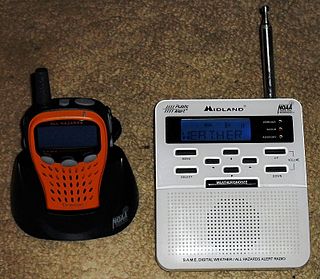
Digital Audio Broadcasting (DAB) is a digital radio standard for broadcasting digital audio radio services, used in many countries around the world, though not North America where HD Radio is used instead.

Broadcasting is the distribution of audio or video content to a dispersed audience via any electronic mass communications medium, but typically one using the electromagnetic spectrum, in a one-to-many model. Broadcasting began with AM radio, which came into popular use around 1920 with the spread of vacuum tube radio transmitters and receivers. Before this, all forms of electronic communication were one-to-one, with the message intended for a single recipient. The term broadcasting evolved from its use as the agricultural method of sowing seeds in a field by casting them broadly about. It was later adopted for describing the widespread distribution of information by printed materials or by telegraph. Examples applying it to "one-to-many" radio transmissions of an individual station to multiple listeners appeared as early as 1898.
Radio Data System (RDS) is a communications protocol standard for embedding small amounts of digital information in conventional FM radio broadcasts. RDS standardizes several types of information transmitted, including time, station identification and program information.
A broadcast range is the service area that a broadcast station or other transmission covers via radio waves. It is generally the area in which a station's signal strength is sufficient for most receivers to decode it. However, this also depends on interference from other stations.
Digital radio is the use of digital technology to transmit or receive across the radio spectrum. Digital transmission by radio waves includes digital broadcasting, and especially digital audio radio services.

NOAA Weather Radio is an automated 24-hour network of VHF FM weather radio stations in the United States that broadcast weather information directly from a nearby National Weather Service office. The routine programming cycle includes local or regional weather forecasts, synopsis, climate summaries, synopsis or zone/lake/coastal waters forecasts. During severe conditions the cycle is shortened into: hazardous weather outlooks, short-term forecasts, special weather statements or tropical weather summaries. It occasionally broadcasts other non-weather related events such as national security statements, natural disaster information, environmental and public safety statements sourced from the Federal Communications Commission's (FCC) Emergency Alert System. NOAA Weather Radio uses automated broadcast technology that allows for the recycling of segments featured in one broadcast cycle seamlessly into another and more regular updating of segments to each of the transmitters. It also speeds up the warning transmitting process.
SHOUTcast DNAS is cross-platform proprietary software for streaming media over the Internet. The software, developed by Nullsoft, is available free of charge. It allows digital audio content, primarily in MP3 or High-Efficiency Advanced Audio Coding format, to be broadcast to and from media player software, enabling the creation of Internet radio "stations".

Nielsen Audio is a consumer research company in the United States that collects listener data on radio broadcasting audiences. It was founded as the American Research Bureau by Jim Seiler in 1949 and became national by merging with Los Angeles-based Coffin, Cooper, and Clay in the early 1950s. The company's initial business was the collection of broadcast television ratings.
Mobility management is one of the major functions of a GSM or a UMTS network that allows mobile phones to work. The aim of mobility management is to track where the subscribers are, allowing calls, SMS and other mobile phone services to be delivered to them.
Radio broadcasting began in New Zealand in 1922, and is now dominated by almost 30 radio networks and station groups. The Government has dominated broadcasting since 1925, but through privatisation and deregulation has allowed commercial talk and music stations to reach large audiences. New Zealand also has several radio stations serving Māori tribes, Pacific Island communities, ethnic minorities, evangelical Christians and special interests.
Station identification is the practice of radio or television stations or networks identifying themselves on-air, typically by means of a call sign or brand name. This may be to satisfy requirements of licensing authorities, a form of branding or a combination of both. As such, it is closely related to production logos, used in television and cinema alike.

Traffic Message Channel (TMC) is a technology for delivering traffic and travel information to motor vehicle drivers. It is digitally coded using the ALERT C or TPEG protocol into RDS Type 8A groups carried via conventional FM radio broadcasts. It can also be transmitted on Digital Audio Broadcasting or satellite radio. TMC allows silent delivery of dynamic information suitable for reproduction or display in the user's language without interrupting audio broadcast services. Both public and commercial services are operational in many countries. When data is integrated directly into a navigation system, traffic information can be used in the system's route calculation.

RTL, formerly Radio Luxembourg, is a French commercial radio network owned by the RTL Group. Founded in 1933 as Radio Luxembourg, the station's name was changed to RTL in 1966. It broadcast from outside France until 1981, because only public stations had been allowed until then.
LIVE365 is an Internet radio broadcasting and listening network where users are able to create their own online radio stations, or choose to listen to thousands of human curated stations created by people from around the globe. LIVE365 is unique in that online radio stations on the LIVE365 network were created and managed by music and talk enthusiasts, including both hobbyists and professional broadcasters. LIVE365 also has many well established AM and FM stations that utilized the LIVE365 broadcasting platform to simulcast their terrestrial radio streams via the Live365 distribution network. The Live365 network also features radio stations from well-known artists such as Johnny Cash, David Byrne, Pat Metheny, Jethro Tull, Frank Zappa, and more. LIVE365 was created in 1999, and remains one of the longest running internet radio websites for listeners and broadcasters.

FM broadcasting is a method of radio broadcasting using frequency modulation (FM) technology. Invented in 1933 by American engineer Edwin Armstrong, wide-band FM is used worldwide to provide high-fidelity sound over broadcast radio. FM broadcasting is capable of better sound quality than DAB/+ radio, and AM broadcasting under normal listening conditions, so it is used for most music broadcasts. Theoretically wideband AM can offer equally good sound quality, provided the reception conditions are ideal. FM radio stations use the very high frequencies. The term "FM band" describes the frequency band in a given country which is dedicated to FM broadcasting.
Audience measurement measures how many people are in an audience, usually in relation to radio listenership and television viewership, but also in relation to newspaper and magazine readership and, increasingly, web traffic on websites. Sometimes, the term is used as pertaining to practices which help broadcasters and advertisers determine who is listening rather than just how many people are listening. In some parts of the world, the resulting relative numbers are referred to as audience share, while in other places the broader term market share is used. This broader meaning is also called audience research.

WHB is a commercial AM radio station in Kansas City, Missouri, United States. The station is owned by Union Broadcasting and it airs an all-sports radio format. For most of the 1960s and 70s, while it was broadcasting at 710 AM, WHB was one of the nation's most influential Top 40 outlets.

A weather radio is a specialized radio receiver that is designed to receive a public broadcast service, typically from government-owned radio stations, dedicated to airing weather reports on a continual basis, with the routine weather reports being interrupted by emergency weather reports whenever needed. Weather radios are typically equipped with a standby alerting function—if the radio is muted or tuned to another band and a severe weather bulletin is transmitted, it can automatically sound an alarm and/or switch to a pre-tuned weather channel for emergency weather information.

RNIB Connect Radio is a British radio station that is part of Royal National Institute of Blind People and was Europe's first radio station for blind and partially sighted listeners. It broadcasts 24 hours a day, 7 days a week online, on 101 FM in the Glasgow area, and on Freeview channel 730. Live shows make up around half of the station's output, with the overnight schedule being used as a showcase for the best music, features, interviews and articles from the past few days. Most of the presenters are blind or visually impaired. From 2007 until early 2016 it was known as Insight Radio.
HMWN Radio Maria is a non-commercial Catholic broadcaster which operates as a closed circuit Subsidiary Communications Multiplex Operation (SCMO) and uses the subcarrier frequency of 67 kHz removed from the centre FM broadcast frequency of 102.1 MHz in Toronto, Ontario. HMWN's offices and studios are also located in Toronto.









